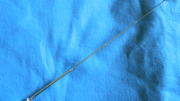Cool title, right? So what is this about? It is about being up to trying anything, as long as it is safe. In this case, to get the best over-the-air (OTA) TV signal we can.
I got this idea by reading a recent blog article by Stuart Sweet, it was his article on “How far away should two antennas be when stacking?“published on Feb 4, 2022. You can read it by clicking on the link.
Here’s the thing: stacking is a science. It will increase our signal. We can stack as many antennas, with coax connections, as we can afford if that’s what we want to do with our time and money.
Assuming that we don’t have unlimited resources of either time or money, then the question is, “what’s the best I can expect to do with my limited resources?” Or, in my case, what’s the best I can do with my limited resources and the mitigating fact that I’m also a bit lazy?
You might ask, Why are you lazy Phil? You don’t seem lazy. I think it all stems from a math teacher I had who said, “The best mathematician is a lazy mathematician.” What she meant was that the “lazy” mathematician will take the time to think about things before starting to solve a problem. Basically this is what I like to do, sometimes to the exasperation of my wife if it’s a family issue needing solving.
Example:
The teacher gave a very convincing example of a former student, who ended up solving a “simple” math problem by thinking about the problem and the math involved. He spent about half the time thinking and in only 15 seconds he then solved the problem before everyone else in the class. The problem was, “what is the total of adding all the numbers from 1 to 1000?” It can be done in the brute force way, starting with one and adding all numbers up to 1000 or as this student noticed. The solution is found by adding 0 + 1000, 1 + 999, and 2 + 998, etc. all the way up to 499 + 501 since these all = 1000. Then he had only the number 500 left over and 500 additions equaling 1000, thus the problem reduces to: 500 X 1000 + 500 which equals 500,500, or 500(1000 + 1)=500,500.
Pretty slick, right? So, how can we now be “lazy” with our TV antenna issue of stacking antennas?
Let me clarify something Stuart said in the article, he said that the antennas should be “…no closer than half the wavelength of the lowest channel either antenna will pick up.”
The truth is a bit more complicated because TV antennas can work from VHF to UHF, which to the ham radio guy, seems like a plethora of frequencies. The bandwidth is huge compared to what ham radio folks are used to working with when stacking antennas.
The theory, and practice, however is the same. The statement, “one half wavelength” for spacing antennas should really be “odd half-wavelengths” so, 1/2, 3/2, 5/2, etc. This spacing is not the physical spacing of the antennas from one another, which can be much closer than that, but of the length of the wire between the antennas. These two lengths are not the same thing because a signal traveling in the coax travels slower than it does in air or vacuum. So we’re really talking about the “electrical” half-wavelength, not the spacing half-wavelength. To calculate this coax length you need to know the velocity factor of the coax you are using. (I won’t go into the calculation for the correct length for a given lowest frequency or channel. There are numerous coax length calculators on the web if you need this). Enough said about the half-wavelength spacing of two or more antennas. But one more point should be made, it is that as you stack antennas you reduce the viewing angle which is what increases the gain.
My point here is not to get the exact length of anything, but to show that sometimes trying something rather than buying something may get you where you want to go, in other words be both lazy (think about it first) and cheap!
First example: Shortly after becoming a ham radio operator I upgraded from Novice to Advanced. With the Advanced license I now had a license allowing me access to the VHF and UHF ham bands. At this point I bought an HT (Handy-Talkie, aka a Walkie-Talkie) but with that and the antenna (called a rubber duck) that came with the HT, I could not access any repeaters in the local area reliably. I already had put an 80/40 meter dipole about six to seven feet above the roof. My thought was, I could use the same coax. Since the larger dipole kept the center plastic mounting plate mostly horizontal, I could mount a short two-meter dipole vertically from it and see if that would help me get into our Carroll county’s club repeater. Note: A repeater is the forerunner of present day cell sites for our phones. The tests of my new 2m dipole proved far more successful than I’d hoped. I was able to get into repeaters from five local counties and the city of Baltimore. This was all for the price of a short piece of wire, some solder, and my time and efforts to attach everything correctly.
Second example: We were watching the Winter Olympics in China this year (2022) and the signal was getting flaky, cutting out at important times during an event. Unfortunately, it never seemed to flake out during an unimportant talking section, only during an event we wanted to see.
For some time now I’d been thinking of finding a way to get the signal from one of my other antennas to our main TV, and my reading of Stuart’s connecting multiple antennas article gave me an idea. Since I thought that Stuart really meant the electrical half wavelength of the coax, not the spacing of the antennas and that I have a TV in the basement bedroom connected to both antennas – the main one in the attic and a home brew porcupine antenna I use in the garage for local Baltimore stations and our favorite public TV station from Washington D.C. I removed the coax for the two antennas from an antenna switch for that TV. I then connect the coax for the two antennas together. I tested the results at the TV of interest and the problem was gone. Over the remainder of the Olympics we were able to watch without missing anything. While at times there was some minor pixelation at times the picture and sound were never lost. I recently made this a permanent change but did it is such a way that both TV have the connection to both antennas. This was done by taking an old one input to two output signal splitter apart, and simply connecting all three coax connections together. See the GE- AV23218 Signal Splitter (2 way) (23218) for the type of splitter I modified.
In both of these cases, I spent no money to test an idea. I don’t even know the overall length of the two pieces of coax I connected together for the TV antenna test. On top of that, both antennas have amplifiers as well. I did think about that before I tried this, but I remembered that neither of the amps I used were powered remotely, meaning I was not using the coax as a power conduit as well as a signal conduit. So there was no need to be concerned about possible power/voltage interference. As for the ham antenna test, I only needed time, effort, two short pieces of stiff wire, and some solder.
In conclusion, you have nothing to lose from testing simple ideas and, possibly, much to gain. There will always be the option to call the people at Solid Signal for advice and good products.
If you have an antenna problem, come up with an idea, see if there’s a way to test this idea with the equipment you have, to see if you can do what you want to do without spending much money, or time and effort. You can always expand from there with better cable, connectors, antennas, and amplifiers. If the test is successful, you may not need to do anything more at this time. This does not mean you can’t or won’t want to expand on your idea and add better equipment at some later date.
With this method you have almost nothing to lose. You may find that, like me, you may enjoy testing the idea and even if it doesn’t work, this may lead you to another idea that does work.
Until next time, happy OTA TV Experimenting!
Phil / KE3FL
All my blog articles are listed at: Karras’ Corner
https://blog.solidsignal.com/author/philk/
or
Karras’ Corner Article Links on my KE3FL Website
http://cs.yrex.com/ke3fl/KarrasCorner.htm
What Have You Got To Lose?





